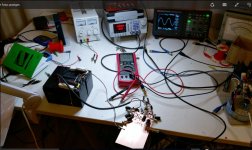We decided to design a new phono stage and make ready made modules availlable. We are also thinking to offer a fitting PSU and maybe a cabinet.
All you have to do is assemble the unit mechanically and do some soldering.
All you have to do is assemble the unit mechanically and do some soldering.
We decided to design a new phono stage and make ready made modules availlable. We are also thinking to offer a fitting PSU and maybe a cabinet.
All you have to do is assemble the unit mechanically and do some soldering.
Interesting.😀
What have you in mind topology wise?
We are thinking about a balanced transimpedance input with bipolars that are DC biased so we do not need the big electrolytics any more.
We will also not need to parallel several input transistors to get the noise down.
That goes then into a novel mirror that also has the buffer directly integrated.
So it is current in - mirror - one shot RIAA - voltage out.
That way we can avoid some transistor junctions.
It is at the same time simpler and more elegant then the Paradise.
I know that we will loose the ability to set input impedance, that is fixed in this design.
On the other hand there is some measure of automatic gain. A cartridge with low impedance will enjoy more gain then a cartridge with high impedance.
That could be viewed as some kind of shunt feedback. Call it current feedback or degeneration if you will. Theoretical that lowers distortion.
The circuit is also superb in supressing the effects of click and pops when the record is dirty or worn. The input impedance is not zero though like in a phono clone.
We simulated several cartridges into zero ohm and found a loss in very high treble.
We will also not need to parallel several input transistors to get the noise down.
That goes then into a novel mirror that also has the buffer directly integrated.
So it is current in - mirror - one shot RIAA - voltage out.
That way we can avoid some transistor junctions.
It is at the same time simpler and more elegant then the Paradise.
I know that we will loose the ability to set input impedance, that is fixed in this design.
On the other hand there is some measure of automatic gain. A cartridge with low impedance will enjoy more gain then a cartridge with high impedance.
That could be viewed as some kind of shunt feedback. Call it current feedback or degeneration if you will. Theoretical that lowers distortion.
The circuit is also superb in supressing the effects of click and pops when the record is dirty or worn. The input impedance is not zero though like in a phono clone.
We simulated several cartridges into zero ohm and found a loss in very high treble.
That sounds pretty interesting and if it works as well as your Paradise then it’s going to be awesome.😀
If you are going to have the boards prefabricated then SMD would be nice and make for a compact over all build.
I’m still SE at the moment but a balanced stage with the magic of the Paradise.
I’m tempted.
Keep us posted 😉
If you are going to have the boards prefabricated then SMD would be nice and make for a compact over all build.
I’m still SE at the moment but a balanced stage with the magic of the Paradise.
I’m tempted.
Keep us posted 😉
Yes, we sure will expore SMD.
The input also works with normal RCA / Chinch connectors provided that ground is not connected to the RCA´s.
The input also works with normal RCA / Chinch connectors provided that ground is not connected to the RCA´s.
Hello Mr. Gerard,
I know that you're very busy, but I was wondering if you were still planning on making the Zion?
Thank you,
Ponger
I know that you're very busy, but I was wondering if you were still planning on making the Zion?
Thank you,
Ponger
Frans and i have made an input stage. It is more or less a combination of what we learned.
It is differential in - differential out so that allows for balanced operation. It is DC coupled.
It is low noise without paralleling many transistors. It is conceptionally simple but high performance. I build a prototype today and i am impressed. I show you pictures and more data soon.
It is differential in - differential out so that allows for balanced operation. It is DC coupled.
It is low noise without paralleling many transistors. It is conceptionally simple but high performance. I build a prototype today and i am impressed. I show you pictures and more data soon.
Here is a sinewave and a 10kHz square. Open loop bandwidth is 210kHz ( -3dB ), open loop differential gain is around 800 x.
The circuit is thermally stable and has no overshot without compensation. I am impressed how close this build came to the simulation.
The circuit is thermally stable and has no overshot without compensation. I am impressed how close this build came to the simulation.
Attachments
- Home
- Vendor's Bazaar
- Zion, a ready made Phono Stage by the Paradise team

